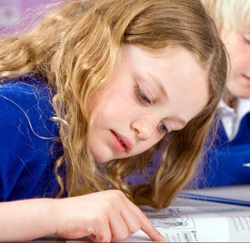Eyes CAN Learn
The purpose of this website is to provide parents with fun eye exercises to enhance their children’s visual processing skills for better school performance and improved attention. If you know a child who struggles to read, learn, or remain on task, the underlying cause may be vision–even if the child has 20/20 eyesight.
Visual Processing Skills
When most parents think about vision, they think about their children’s eyesight, i.e., visual acuity as measured by the eye chart. When children have 20/20 vision, it means they can see what an average person sees on the eye chart at a distance of 20 feet. If children fail the eye chart test, they can get glasses to compensate for their eyes’ physical irregularities that cause blurry vision. But good vision is so much more than just clear eyesight at distance.
 Near visual skills at close ranges are especially important to school-aged children, who spend their days viewing images at a distance of 20 inches, not 20 feet. Looking up close is much more demanding on our visual system than looking far away and involves very precise visual skills in the way we take in, or process, visual information. At these close distances, children need to the ability to coordinate or “team” their eyes in order to maintain single vision. They need to be able to track a line of print without losing their place. They need to the ability to quickly adjust focus when looking from near to far, as when they’re copying from the board. Children also need to be able to interpret and make sense of what they see, commonly referred to as visual perception. Glasses cannot correct these types of problems because, unlike eyesight, visual processing problems are not caused by physical irregularities in the shape of their eyeballs. Rather, these visual processing problems are hard-wiring deficits in the brain caused by poor visual development in the first few years of life.
Near visual skills at close ranges are especially important to school-aged children, who spend their days viewing images at a distance of 20 inches, not 20 feet. Looking up close is much more demanding on our visual system than looking far away and involves very precise visual skills in the way we take in, or process, visual information. At these close distances, children need to the ability to coordinate or “team” their eyes in order to maintain single vision. They need to be able to track a line of print without losing their place. They need to the ability to quickly adjust focus when looking from near to far, as when they’re copying from the board. Children also need to be able to interpret and make sense of what they see, commonly referred to as visual perception. Glasses cannot correct these types of problems because, unlike eyesight, visual processing problems are not caused by physical irregularities in the shape of their eyeballs. Rather, these visual processing problems are hard-wiring deficits in the brain caused by poor visual development in the first few years of life.
Visual processing skills develop much the same way our motor skills are acquired, i.e., with practice and use. Just as infants must learn to roll over, crawl, and walk, their eyes must also learn to track, team, focus, and interpret what they see. We’re born with all the eye structures we need for vision, but we spend the first 4-6 months of life getting “hard wired” in the brain’s visual cortex to use our visual equipment correctly, and then we continue fine-tuning these skills throughout early childhood.
 So what happens if something goes wrong, and these important visual skills don’t develop normally? Vision becomes less efficient and takes more effort. Uncomfortable vision is especially noticeable at school where reading becomes an exercise in frustration and fatigue. Depending on the clinical criteria researchers adopt to identify the prevalence of vision deficits, studies show around 20-25 percent of the population have some degree of poor visual processing skills. If we isolate poor readers, this number rises significantly because nowhere is vision more demanding than at close ranges with small print. Each year as the reading demands increase and print gets smaller, children with poor visual processing skills find it harder to maintain clear, comfortable, single vision. Grades start to drop, compre- hension falls, and eyestrain makes it difficult to remain on task, forcing these children to take frequent breaks. They are so often off task that they may look like they have ADD/ADHD, or their grades are so poor that teachers start questioning if they have a learning disability. Unfortunately, few teachers or parents even suspect that the underlying cause may be vision.
So what happens if something goes wrong, and these important visual skills don’t develop normally? Vision becomes less efficient and takes more effort. Uncomfortable vision is especially noticeable at school where reading becomes an exercise in frustration and fatigue. Depending on the clinical criteria researchers adopt to identify the prevalence of vision deficits, studies show around 20-25 percent of the population have some degree of poor visual processing skills. If we isolate poor readers, this number rises significantly because nowhere is vision more demanding than at close ranges with small print. Each year as the reading demands increase and print gets smaller, children with poor visual processing skills find it harder to maintain clear, comfortable, single vision. Grades start to drop, compre- hension falls, and eyestrain makes it difficult to remain on task, forcing these children to take frequent breaks. They are so often off task that they may look like they have ADD/ADHD, or their grades are so poor that teachers start questioning if they have a learning disability. Unfortunately, few teachers or parents even suspect that the underlying cause may be vision.
Click here for information about risk factors for vision-based learning problems: Risk Factors

